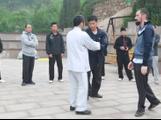Concepts covered in this 32-minute video: 1. Three Way Split. 2. How to be continuous and don’t stop the momentum. 3. How the three way split functions and enhances fajin skill. 4. How to find the point to fajin from. 5. How to find the one point to fajin to. 6. Lever point. 7. Demarcation line.
Author: Chen ZhongHua Length: 32 min. In: English Year: 2010 Difficulty:4/5 At:Edmonton



{ 7 comments… read them below or add one }
Master Chen has created another video to cover advanced concepts that are difficult to do, but with his demonstrations we have a clearer picture of what needs to be developed. Each of the concepts covered are vital to actually “doing” Taiji instead of just “doing the form”. Another major addition to our Taiji knowledge!
Another great video. The three way split concept is something I have never heard of in my 18 years of taichi. Doing the circles and just hearing it explained one would be prone to dismiss the importance or reality of it. Seeing Master Chen apply the concept and technique shows and proves the validity. Again, this is totally different than what most/all other taichi styles do and teach (which to me always seemed to be too much on the physical side, something was always missing, but I didn’t know what it was, and now I am starting to see). These are the real “secrets” of taichi that few possess.
This short explanation really helped me understand what I should be doing in performing the positive circle. What really helped was the concept of pushing down/dropping the weight/shoulder down on the front leg and then the energy splitting with the waist separating back and the hand/arm separating forward. The key concept that Master Chen mentioned was not having the front knee drop or move down. It seems the energy has no where else to go but to the sides. I can now feel the squeeze with the separation occurring forward and back.
By slightly dropping the back kua and pushing the foot into the ground (while not moving the front and rear kua), creates a spiraling and causes the waist to turn back as well as squeezing the torso which causes the chest to hollow and the back to round (han xiong ba bei). This squeezing or compression of the torso squeezes/pushes the arm out and causes the lower part of the body to move backward (like another three-way split).
Master Chen, does this seem to be an accurate description? You seem to have been able to refine your movements over much time and practice so that now your movements are much smaller and not as perceptible. One cannot really perceive the totality of the movements as you have “internalized” them. Can one say that this is what is meant by taichi being an “internal” art?
Thank you!
Gary Readore
Gary,
Again your descriptions are accurate. Yes, this is what is meant by “internal” but this is not all of it. It is part of it. As to my movements being small. This is purely a matter of perception. My tossing movements are smaller (there is still plenty) and “three-way split” movements are larger. This causes the untrained person not to see the movements. This is the reason people say that at a higher level, the circle becomes very small. The truth of the matter is that at a higher level, the circles and “three-way split” type of taiji movements become very large, therefore more power.
Another important factor is that when the “three-way split” is done correctly, the performer does not receive any feedback. Feedback is only when you do something wrong. This is the most difficult problem for students of taiji. Students will never know whether they are doing it right or wrong without a good teacher telling them.
This video really showed why the positive and negative circles are so important. They are the foundation to the system as they are training exercises to feel and generate the three-way split as well as maintaining the alignment on the dot. This has helped broaden my understanding of what I am supposed to be doing in the circle exercises.
Once again, like many of Master Chen Zhonghua’s lessons, these are wonderful explanations of push hands/ taiji theory. The 3 way split is naturally produced in the form but learning to work this concept in push hands is very difficult. This video helped me to become more aware of the 3 way split and I am beginning to understand that lever development and sensitivity is innately apart of chen taiji movement and qi flow. Thank you so much!
Very good and clear instruction, thank you.
It seems that this method has imbeded high physics and universal principles, in terms of how
energy-(newtonian force involved in fight) works through geometry of the body.
The dot of oncoming energy is splitted with the “unreal dot”, to use the description of Master Hong
from the book. This energy is converted in spirals, the energy shape is a vortex.
A taiji master replicates a vortex. If you touch him you ar sucked in or repelled.